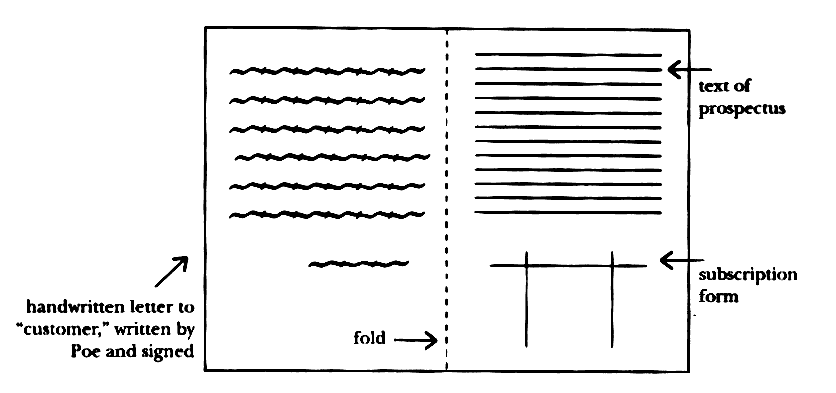∞∞∞∞∞∞∞
PROSPECTUSES FOR “THE PENN” AND “THE STYLUS”
Sour experiences working for magazine proprietors and his sure sense that he could make a magazine thrive led Poe to formulate plans for a journal of his own. The magazine would be popular and thereby provide him with a good living, for, as he several times boasted, he knew how to build circulations. But it would also have high standards. When I (SGL) taught this material in Europe, my students were surprised to learn that Poe had enough confidence in the sophistication and taste of the American reading public to feel that popularity and quality were not incompatible.
In his earlier proposals, Poe called his journal “The Penn”; later he decided that “The Stylus” was a better title. A pen and a stylus serve the same function, after all, and “Penn” suggested a more regional (“local,” Poe says in the March 4, 1843, version) character than he ultimately desired.
Because the prospectuses that he wrote to attract donors and subscribers explained what he planned and how the standards would be set, they are considered important critical documents. They are closely related in content to the larger critical essays in this volume. Indeed, a number of Poe's major works — the quasi-scriptural cosmological “prose poem” Eureka, “The Poetic Principle,” and “The Rationale of Verse,” for instance — connect intimately to magazine founding.
Both Eureka and “The Poetic Principle” were drafted first as public lectures, delivered, Poe said, in order to raise money for the magazine. “The Rationale of Verse” was an expanded version of a piece that Poe published in James Russell Lowell's new magazine The Pioneer. Poe's letters to Lowell about the essay include discussions of Poe's plans to found his own magazine and praise Lowell for the editorial ideals espoused in The Pioneer — ideas that were similar to Poe's own (see the headnote to “Notes upon English Verse,” 145-46, for details). That The Pioneer promptly failed might make one question Poe's optimism.
In Discoveries in Poe, Pollin traces “Poe's thought about the role of the magazine in national culture and the role of criticism” (227) through [page 22:] Poe's magazine prospectuses. Poe twice used the name Launcelot Canning in “The Fall of the House of Usher” (1839) and in the 1848 prospectus of “The Stylus” (see the note to the motto of the 1843 “Stylus” prospectus). The name likely derives from two sources, first, the “William Canynge” whom Thomas Chatterton invented as the patron of his author-monk in the “Thomas Rowley” poems; and second, Tennyson's poem “The Lady of Shalott,” which, as Pollin shows, Poe knew well and in which, in the early editions, the archaic spelling of the name appeared.
Pollin explains Canning's relationship to the proposed titles for Poe's magazine, describes the development of the prospectuses in the context of Poe's career, provides texts of the 1843 and 1848 prospectuses for “The Stylus,” and compares those versions with the prospectus for “The Penn” (1840). We agree with Pollin's judicious conclusions. On the one hand, Poe moves from the fellow feeling of earlier versions to “a more disillisioned” tone; on the other, he comes to promise coverage of cultural areas beyond literature. But “The Stylus” was still to bear the strong stamp of its editor's standards and critical intelligence.
A series of letters by Poe relating to the his projected journal has survived and appears in the Ostrom edition of Poe's Letters. Some were written directly on the brochures that contain versions of the prospectuses. The letters record a sad, gradual fall of hopes.
Note on the Text of the
Prospectus of “The Penn Magazine”
Poe had his prospectus of the Penn printed as a kind of brochure, made to be mailed. It is a single sheet with the text printed on half of one side so that the sheet could be folded to provide a convenient place for writing a personal letter to the potential subscriber; this left the back free for the address.

∞∞∞∞∞∞∞
Notes:
None.
∞∞∞∞∞∞∞
[S:0 - SSLCT, 2009] - Edgar Allan Poe Society of Baltimore - Editions - EAP: Critical Theory (S. and S. Levine) (Prospectuses - Headnote)